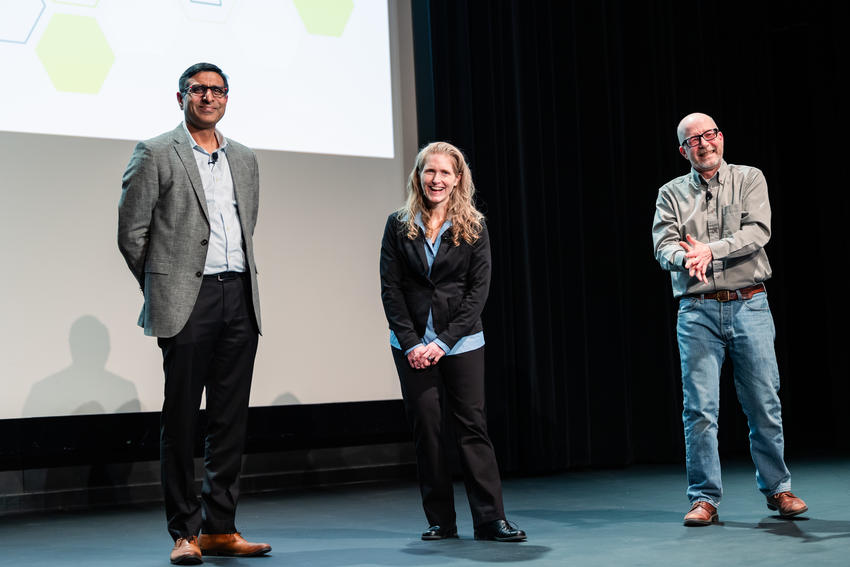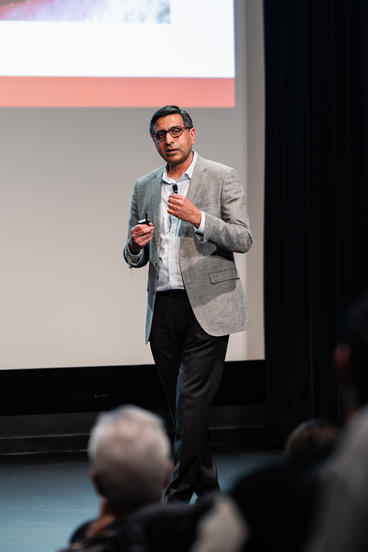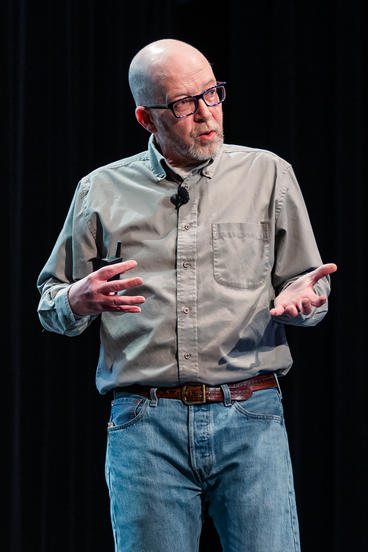Research Innovations Seminar Series explores discoveries impacting patient care

The School of Dentistry held a Research Innovations Seminar Series event on February 2, 2024.
Inspired by the school’s mission to advance health through scientific discovery, innovative education and the highest-quality care for all communities, the Research Innovations Seminar Series invites experts to showcase their research and discovery to a wide audience, condensing complex and difficult questions into a digestible format.
“We are excited to highlight the excellent research enterprise of our school today,” said Kristin Artinger, PhD, Associate Dean for Research and Discovery, in her remarks welcoming individuals to the event. “We have highlighted three cutting-edge researchers, who will tell you a bit about their work and its potential to advance patient care in the future.”
Speaking at the event were Julie Olson, PhD, associate professor of basic sciences, director of graduate studies in oral biology and director of the Summer Research Fellowship Program; Rajaram Gopalakrishnan, BDS, PhD, professor of oral and maxillofacial pathology and Director of the Division of Oral and Maxillofacial Pathology; and Paul Jardine, BSc, DUT, PhD, professor of basic sciences and Interim Director of Admissions.

Olson began the event with her talk, entitled “Neuroinflammation: The good and the bad,” inviting attendees to consider how a household is thrown off balance when an illness in a family occurs. This system, she explained, is similar to how the central nervous system operates.
“A highly-regulated system has been developed to protect the brain and spinal cord, because the functions they do are essential,” she said. Olson shared her research on microglia, one of the “members” of the central nervous system household that take on immune functions. Exploring the good and bad of neuroinflammation initiated by the microglia, Olson shared the role of microglia in viral infections, chronic pain and more. She then described ways of “turning off the microglia” to disrupt inflammation in instances of chronic pain while maintaining the benefits of the immune response.
“Neuroinflammation was designed to protect our central nervous system, and it works really well,” she explained. “But you can fall into difficulties when things go wrong. Just like our house, when someone is sick, we want to make them better—but when they get better, we should all return to normal. That’s what we’re trying to do with the central nervous system: return it to normal, where everyone is happy and healthy.”
Gopalakrishnan invited attendees to consider a scenario in which a six-year-old comes into a provider’s office for an oral cancer screening: a rare and surprising experience for most providers.

“Immediately, your brain is working overtime,” he described. “Why is a six-year-old child here to see me?” Then, the mother in the scenario explains that the child has been diagnosed with Fanconi Anemia.
“Fanconi Anemia is a genetic disease where the patients have a defect in DNA repair, specifically an inability to repair interstrand crosslink DNA damage,” he shared. “Because of that, they have very significant consequences, like bone marrow failure, birth defects and high risk for cancer—more specifically, oral cancer.” He explained that Fanconi Anemia patients have a 700-fold increased risk for developing oral cancer, and that it develops more rapidly and at younger ages.
“This is where we come in,” Gopalakrishnan explained. As stem cell transplants and other therapies have allowed patients with Fanconi Anemia to live longer, they are at an increased risk of developing oral cancer. “It’s more of a cancer susceptibility disease.”
Because chemotherapy and radiation therapy cannot be used in a patient with Fanconi Anemia, Gopalakrishnan explained, surgical intervention is key. “The way that we can save their lives is to catch these conditions at a very early stage, so treatment can be minimal,” he said.
Gopalakrishnan shared the need for frequent and low-threshold examinations and biopsies for oral cancer in Fanconi Anemia patients, as well as new horizons in less invasive detection options.
“As oral health care providers, we can all play a role in helping these patients,” he said. “I want to challenge us that every time a patient, whether they have Fanconi Anemia or not, comes to your chair, you will do an oral cancer screening. You never know what that impact will be.”

Jardine shared his interest in studying viral motors, stemming from a childhood love of motors in general. “I’ve always been fascinated by machines,” he said. “Machines are everywhere. Biological mechanisms also need to move things from one place to another, and that’s where biological motors come in.”
A long-studied phenomenon in the biological field is the way ring ATPases, an “ancient strategy of building a machine in a biological system,” convert the energy in ATP from chemical to mechanical force.
“For many years, people had fanciful ideas of this process, as if in some magical way, the chemical bond energy was converted to mechanical force,” he said. “No one has ever been particularly satisfied with that explanation, but we’ve been making process in describing how the process occurs.”
Jardine studies this process in viruses that attack bacteria; in particular, the assembly of bacteriophage phi29. He shared a variety of models he and his team came up with to understand how phi29 translates DNA through a motor.
The process was frustrating, and oftentimes did not provide the solutions Jardine wanted to see. “We were upset and frustrated that the models weren’t convenient,” he reflected. “But science is never convenient; it’s just always intriguing.”
Finally, Jardine and his colleagues identified a structural model that correctly represents the structure’s movement between a flat and helical form.
“What happens is, you get this oscillation driven by ATP binding and ATP hydrolysis, of the motor distorting into a helix, and then flattening, driving the DNA up, and going through it again,” he said. “It’s this helix-to-planar mechanism that we feel best illustrates the mechanical principles of how this works. No magic required, no mystical chemical energy becoming mechanical force—but just playing off this oscillation between these two structures, with the net movement of DNA through these molecules.”
Watch the talks.